A Franco-German centenary?
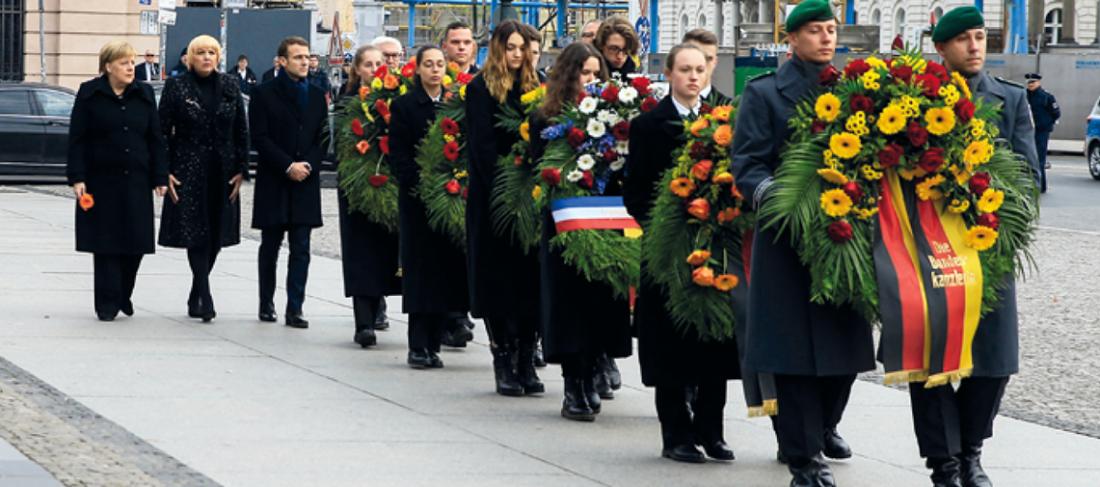
The unprecedented commemorations of the First World War centenary saw a flurry of Franco-German events. If France seemed to be the driving force behind the centenary, its partner across the Rhine was happy to go along with it, mobilising institutional and cultural networks to make the commemorations a Franco-German event.
The First World War centenary gave rise to a long remembrance sequence (2014-2018) on an entirely unprecedented scale. Experts forecast that different countries would have varying degrees of enthusiasm for the commemorations, depending on the national history and remembrance tradition of each one. As a result, an analysis of the centenary needs to be re-situated within a complex set of geopolitical factors, with national histories at its heart. What role did France and Germany play in the centenary? With different perceptions of the First World War in the two countries, is it justifiable to speak of a Franco-German centenary?
Key Franco-German events
The French centenary had long been planned, with the creation of an interministerial Centenary Commission by President Sarkozy as early as 2012. This was not the case in Germany, where the federal government deemed it sufficient to appoint the diplomat Andreas Meitzner as “coordinator” of the commemorations at the culture department of the Ministry of Foreign Affairs. The French Centenary Commission headed by Joseph Zimet was active from 2013 to 2019, and took an all-out approach to the centenary comparable to the war itself, not neglecting any aspect (cultural, diplomatic, military, territorial, academic and media). The Commission was behind much of the organising of France’s national and international commemorations. It oversaw a rich and intense programme over a five-year period, with the participation of Germany wherever appropriate.
The official Franco-German events to commemorate the First World War between 2014 and 2018 must be related in detail here, as much to highlight their frequency as to point out the significant shifts in remembrance policy that they reveal.
These official binational commemorations form part of what is now a long history of Franco-German reconciliation, which began in 1962 with the meeting between de Gaulle and Adenauer in Reims. It reached its high point with the high-profile invitation of Angela Merkel to Paris in 2009 for the Armistice Day commemorations.
To return to the period 2014-18, one key sequence, insofar as it took place over quite a long time, was the planned creation of a Franco-German history museum, the Historial Franco-Allemand, on the Hartmannswillerkopf. The meeting between François Hollande and Joachim Gauck in August 2014 laid the foundations, and the plan became a reality when Emmanuel Macron met Frank-Walter Steinmeier in November 2017. The creation of this binational institution devoted to the First World War was a first, and is compelling evidence of a “convergence of remembrances”.
Resuming our timeline from August 2014, it is worth recalling the meeting between foreign ministers Laurent Fabius and Frank-Walter Steinmeier in May 2015, for the unveiling of the new stained-glass windows in Reims cathedral, Reims being the archetypal First World War “martyr city”. It was practically inconceivable not to commemorate Verdun, where Angela Merkel met François Hollande on 29 May 2016. A message of unified remembrance was once more presented, as the chancellor declared “there are no more graves separating us”.
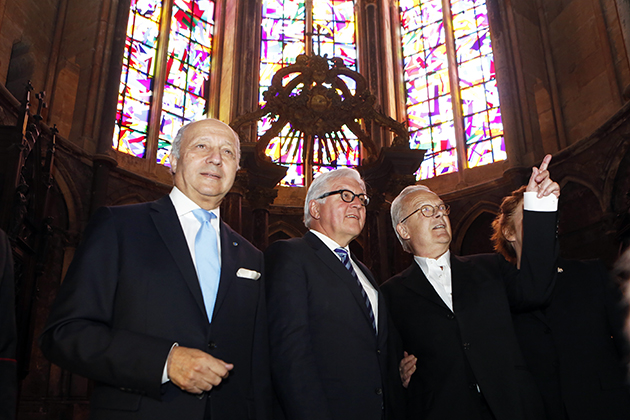
Unveiling the stained-glass windows of the Joan of Arc chapel in Reims cathedral: German foreign affairs minister Frank-Walter Steinmeier and his French counterpart, Laurent Fabius, with master glazier Imi Knoebel, who made the windows, Marne, Champagne-Ardenne region, 11 May 2015. © MEAE / F. de la Mure
Culmination of the path of reconciliation
Finally, the ceremonies of November 2018 brought the commemorations to a solemn close, with the “tour of remembrance” ordered by the French president. Besides the main Armistice Day ceremony, at which over 70 heads of State, including the German chancellor, were represented, two Franco-German events bookended the “tour”: on 4 November in Strasbourg, Emmanuel Macron met Frank-Walter Steinmeier once again, and on the afternoon of 10 November, Macron met Angela Merkel to commemorate the armistice at Compiègne.
The Compiègne ceremony, which can be watched in full on the Élysée Palace website, warrants particular attention. It marked a kind of culmination of the Franco-German path of reconciliation around the First World War. First, the ceremony was almost entirely bilingual. It honoured the military, but unostentatiously, with a review by the two heads of State of troops of the Franco-German Brigade. The French and German national anthems were played one after the other, followed a bit later on by Beethoven’s Ode to Joy, which is also the European Anthem, sung by a children’s choir. Angela Merkel and Emmanuel Macron then made their way to the dalle sacrée (sacred stone slab), where they unveiled a plaque bearing the following inscription: “On the centenary of the armistice of 11 November 1918, Mr Emmanuel Macron, President of the French Republic, and Ms Angela Merkel, Chancellor of the Federal Republic of Germany, reaffirmed here the value of Franco-German reconciliation in the service of Europe and of peace.” Here, the original symbolism of the sacred stone, intended to mark the insurmountable antagonism between France and Germany, is turned on its head. Finally, the two heads of State were received by a representative of the Armistice Clearing Memorial Association, in a subtle tribute to all the “remembrance facilitators”: charity representatives, volunteers, etc. The chancellor and the president then signed the visitors’ book in the famous Armistice Carriage. This final, emotionally charged scene was entirely in keeping with the similar meetings that had come before it since 2014, with the duos François Hollande/Joachim Gauck and Frank-Walter Steinmeier/Emmanuel Macron, in which the rapprochement of the two nations was signified by a physical coming-together of their leaders. In the case of Merkel and Macron, that proximity manifested itself in little, fumbling gestures that seemed almost clumsy (he taking her hand under the photographers’ flashes, for instance), indicating a degree of spontaneity in these historic proceedings.
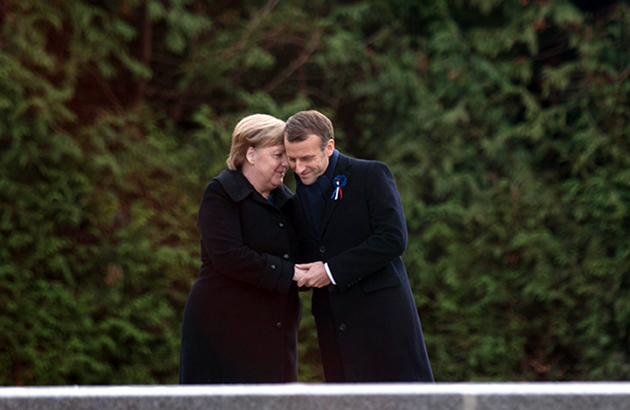
French president Emmanuel Macron and German chancellor Angela Merkel celebrate Franco-German reconciliation,
Rethondes, 10 November 2018. © Soazig de la Moissonnière/Présidence de la République
A centenary revealing of commemorative traditions
Although a certain “convergence of remembrances” may have been rightly observed between France and Germany during the centenary, it is worth noting some small details that illustrate their different points of view in the process. First, it is noteworthy that the commemorative events took place above all in France, and at France’s invitation. This is of course understandable insofar as French territory, in particular its northern and eastern areas, sustained a strong and lasting impact from the conflict, whereas Germany does not have a First World War commemorative tradition. With the exception of the notable session held at the Bundestag on 3 July 2014, which saw the participation of the French Ambassador to Germany and the former president.
Valéry Giscard d’Estaing, France went little to Germany to commemorate the First World War. That same day, Franco-German “cultural intermediary” Alfred Grosser was there to chart a century of bilateral relations rather than commemorate the Great War. In November 2018, just over a week after the international commemoration held in Paris, Emmanuel Macron went to Berlin for Volkstrauertag, Germany’s Day of National Mourning. But there again, it was more to evoke the importance of the Franco-German duo in Europe, and the need to overcome their differences in order to follow a joint policy of major global importance.
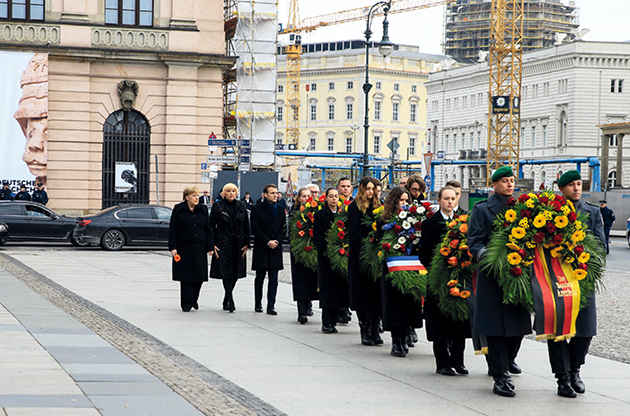
The Day of National Mourning ceremony in Germany, with Emmanuel Macron and Angela Merkel, Berlin, 18 November 2018.
© Abdulhamid Hosbas/AFP
This gap is once again perceptible in two official events that took place very close to one another.
The first was the international ceremony of 11 November 2018 in Paris. Without succumbing to patriotic excess, France’s national symbols were nevertheless very much in evidence: the French air force aerial acrobatics team letting off plumes of red, white and blue smoke over the Arc de Triomphe, and a presidential speech praising France as a bearer of values for which “patriotism is distinguished from nationalism”, quoting Clemenceau and making numerous cultural references about which there is admittedly a consensus today, but which were nevertheless typically French, like Julien Benda and Jules Romains. The poet Apollinaire, who took French nationality in 1916 and with whose words the French president ended his speech, succeeded, it is true, in striking a more “cosmopolitan” balance. Angela Merkel was not invited to speak at this event, any more than any of the other heads of State in attendance.
However, she could be heard a few hours later at the Paris Peace Forum, launched the same year by President Macron. There, she took a stance that might be described as “typically German” in such a remembrance setting: after recalling Germany’s past arrogance, she focused on the dangers of isolationism and lack of communication between the most senior officials. In particular, she put the issue of Franco-German reconciliation in perspective by speaking at some length of the no less difficult reconciliation between Germany and Poland post-1945. These references to the wider context of Eastern Europe and the Second World War are revealing in that they distinguish French and German sensibilities on the issue of remembrance.
Initiatives throughout France and Germany
Although most of the numerous centenary projects organised on either side of the Rhine had a local or national perspective, mention should be made of a small number of significant Franco-German initiatives, made possible primarily by the vivacity of the institutional networks in place in the partner country. Border areas naturally played a special, though not exclusive, role.
The wealth and diversity of Franco-German initiatives organised as part of these commemorations is the most tangible sign of the healthy friendship between the two countries. We won’t discuss here the creation of the Historial Franco-Allemand de la Grande Guerre (Hartmannswillerkopf/Vieil Armand), which is the principal and most lasting testament to this close cooperation. Among the most important accomplishments was the cycle of exhibitions and the accompanying cultural programme in the trinational Upper Rhine area. Boosted by the creation of the trinational 2014 Réseau des Musées/Netzwerk Museen, no fewer than 35 exhibitions of varying sizes were put on in 25 towns and cities in France, Switzerland and Germany.
In 2014, the French History Institute in Germany (IFHA), in Frankfurt, laid on a packed programme of events titled Rück/Blick (look back, review), including an exhibition, talks, colloquia, and film screenings with discussions and workshops. More modestly, in autumn 2014 the University of Saarland hosted a cycle of three talks on the theme of working-class history in the context of the First World War. Given their distance from the French border, there was something surprising about the binational initiatives organised in Osnabrûck (Lower Saxony) and, even more so, in Frankfurt an der Oder (Brandenburg). The former, titled “The other’s viewpoint”, had a strong educational focus. Organised by the city’s cultural museum in partnership with the department of Hautes-Alpes (Gap), it sought to encourage the participating secondary-school students to reach a shared view of the conflict. In the second case, the timely presence of Nicolas Offenstadt, guest lecturer at European University Viadrina Frankfurt (Oder) during this period, meant that a Franco-German symposium on cities in the First World War was able to be held in conjunction with a local exhibition (June 2015). Another interesting binational initiative was the project carried out by a group of French and German students around Hill 108 at Berry-au-Bac, supervised by historian Fabien Théofilakis. Finally, the specific issue of prisoners of war prompted some interesting museum developments, like the one in Giessen (Hesse).
Meanwhile, German science and culture operators in France also played their part in the First World War centenary activities: the Goethe Institute and, in particular, the German History Institute put on a wide variety of events for specialist or wider audiences.
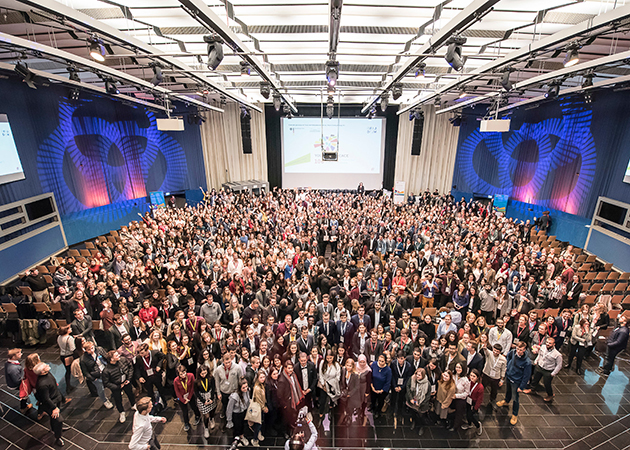
Youth for Peace, Berlin, 2018. © Jennifer Sanchez vonZynski.com
Young people at the heart of the centenary
The Franco-German Youth Office (FGYO), which remains essential to Franco-German cooperation, accompanied the major official bilateral events over the five-year period by holding youth meetings at Hartmannswillerkopf/Vieil-Armand (2014) and Verdun (2016). A call for projects titled “100 projects for peace in Europe” was launched, and the whole cycle ended in mid-November 2018 with an international conference for 500 young people from Europe and neighbouring countries on the theme “Youth for Peace: 100 Years after World War I, 100 Ideas for Peace”. Town twinnings between France and Germany appear not to have given rise to a great many centenary events, despite the fact that 2013 had seen another key commemorative date with the 50th anniversary of the Élysée Treaty. Among the major art exhibitions co-organised by the two countries, the one associating Rouen and Cologne around the theme of cathedrals is worth mentioning, as is the one that saw Reims Museum of Fine Art team up with Wuppertal’s Von der Heydt Museum (“The human abattoir” exhibition). In terms of editorial and audiovisual production, besides the conference proceedings and catalogues of the above-mentioned exhibitions, the following two books were published: La Grande Guerre vue d’en face - 1914-1918 : Vue d’Allemagne, vue de France / Nachbarn im Krieg: Deutsche Sicht, Französische Sicht (Albin Michel) and Une guerre des images : 1914-1918, France-Allemagne (La Martinière). A comic book aimed at children aged 12 and over was also published in the two countries, with the title Carnet 14/18 : quatre histoires de France et d’Allemagne (Buveur d’encre / Tinter Trinker). Finally, in 2013 TV channel ARTE broadcast a Franco-German docu-fiction production titled 14, des armes et des mots (14 - Diaries of the Great War), whose aim was to arouse “human interest” in the fates of 14 protagonists who get caught up in the turbulent course of the conflict.
This non-exhaustive overview of the principal binational initiatives and accomplishments carried out as part of the centenary reflects the dynamism of the Franco-German networks, whether institutional, academic, cultural or voluntary.
The First World War centenary did not fundamentally alter the emphases of the Franco-German partnership around remembrance issues. One might say it was a favourable opportunity to confirm the trend already seen in recent years towards a “convergence of remembrances” between the two countries and an opening-up to Europe. To be sure, each country still has its national peculiarities, but these are marginal. What is most striking is that, ten years on from the deaths of the last remaining survivors of the “great seminal catastrophe”, we commemorate the war, yes, but above all we celebrate peace. And that celebration of peace involves a particular focus on young people, whose presence is very much in evidence both at the official commemorations and in educational and cultural initiatives.
Finally, Alfred Grosser, interviewed by German television in 2018, was probably not wrong when he said, “when it comes to First World War remembrance, the French perhaps go a bit over the top”. However, we would say that if this has the knock-on effect of helping our German neighbours to revisit the period a bit more assiduously, in concert with their former enemy, then it is not such a bad thing.

